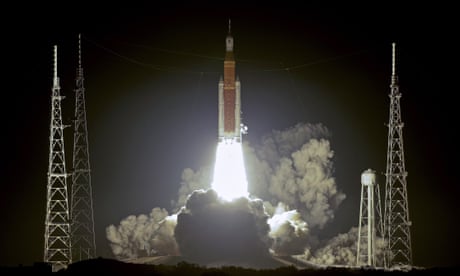- by foxnews
- 08 Apr 2025
Nasa’s Artemis 1, most powerful rocket in history, blasts off to moon
Nasa’s Artemis 1, most powerful rocket in history, blasts off to moon
- by theguardian
- 17 Nov 2022
- in news

Two hurricanes, two months and a number of technical fixes since previous launch attempts were thwarted, and Nasa's Artemis 1, the most powerful space rocket in history, is finally on course for the moon after lifting off from Florida early on Wednesday.
The spacecraft, comprising the mighty Space Launch System (SLS) rocket and pioneering Orion capsule, lit the night sky as it rose from its Cape Canaveral launchpad at 1.47am ET. The 25-day, 1.3m-mile journey to the moon and back is Nasa's first crew-capable deep-space mission for half a century.
"On behalf of all the men and women across our great nation who have worked to bring this hardware together to make this day possible, and for the Artemis generation, this is for you," the launch director, Charlie Blackwell-Thompson, said shortly after liftoff.
It was the first time that the Nasa SLS rocket and Nasa Orion have flown together. "Artemis I begins a new chapter in human lunar exploration," the Space agency tweeted.
No astronauts are aboard the Artemis 1 test flight. But it does contain three mannequins and a Snoopy soft toy gauging radiation levels and testing new life-preservation systems and equipment designed for the next generation of long-duration human spaceflight.
Success of the mission, which will culminate in a Pacific ocean splashdown on 11 December, is crucial to the Artemis 2 and 3 flights that will follow. Both will ferry humans to and from the moon, with the latter, scheduled for 2025 but expected to slip back a year, being the first crewed lunar landing since Apollo 17 in December 1972.
Artemis 3 will add a woman's name to the only 12 moonwalkers in history - all men from the Apollo flights between 1969 and 1972. A subsequent mission of Artemis, in Greek mythology the twin sister of Apollo, will land the first person of color, the space agency says.
While the Apollo missions provided humanity's first hands-on look at our nearest celestial body, much more than basic exploration is driving Nasa's return.
"Why the moon?" Nasa administrator Bill Nelson told the Guardian last year. "Because the goal is Mars. What we can do on the moon is learn how to exist and survive in that hostile environment and only be three or four days away from Earth before we venture out and are months and months from Earth.
"That's the whole purpose: we go back to the moon, we learn how to live there, we create habitats."
Nasa wants to establish a long-term human presence, including construction of a lunar base camp, as groundwork for crewed missions to Mars by the mid-2030s. Its wider Moon to Mars vision includes commercial partners such as Elon Musk's SpaceX and the heavy-lift Starship rocket that could be ready for its first orbital test flight as soon as next month.
First, though, Nasa must prove after a 50-year gap that it is up to the challenge of sending vehicles into deep space and returning them safely to Earth.
Wednesday's launch followed scuppered attempts in August and September. Those were scrapped after engineers discovered an engine cooling problem, then were unable to fix what was reported as an unrelated fuel leak, but which was later traced to a faulty sensor.
Nasa's hope of trying in early October was curbed when the threat of Hurricane Ian forced the space agency to roll the giant $4.1bn rocket back to its hangar.
Artemis returned to the launchpad on 4 November, and remained there last week through 100mph gusts from Hurricane Nicole. Mission managers gave a final go-ahead for launch after conducting "minor" repairs on electrical systems, and determining a torn strip of silicone weather covering was not a show-stopper.
Jim Free, Nasa's associate administrator for exploration systems development, said there had been a robust debate about pressing forward with Wednesday's launch.
"Even at the final decision poll there was discussion about, 'Hey, let's make sure we're understanding and talking through all the issues,'" he told reporters.
"I can tell you that the team absolutely did that. The group that cares the most about this rocket is the group making those decisions. I would never expect, nor have I ever heard, any overconfidence or cavalier nature."
Orion launched atop the most powerful rocket ever built, with 8.8 million pounds of thrust, 1.3 million greater than the Saturn V behemoths of the Apollo era.
Artemis will fly farther than any spacecraft built for humans, Nasa says. It will travel 280,000 miles (450,000km) from Earth, and 40,000 miles (64,000km) beyond the far side of the moon.
Orion will also stay in space longer than any human spacecraft has without docking to a space station, and return home faster and hotter than ever before.
- by foxnews
- descember 09, 2016
Ancient settlement reveals remains of 1,800-year-old dog, baffling experts: 'Preserved quite well'
Archaeologists have recently unearthed the remarkably well-preserved remains of a dog from ancient Rome, shedding light on the widespread practice of ritual sacrifice in antiquity.
read more


